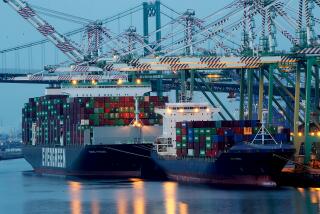Hong Kong Uses Cheap Labor to Make Toys : Many of Santaâs âElvesâ Reside in China
HONG KONG â Most of the toys that Santa will use to fill childrenâs stockings this Christmas are the products of a non-traditional partnership between the spirit of capitalism and communist China.
The worldâs most populous nation is now a major manufacturer of Christmas toys, and that role is expected to grow.
The tiny British colony of Hong Kong, off the southeastern tip of China, is the worldâs largest toy supplier. Mainland China has a huge, cheap labor supply. What has resulted is a financial marriage made for the bottom line.
âWe are using China as a cheap labor supplier but relying on our own know-how and money,â said Bill Blaauw, explaining how China became a subcontractor to Hong Kongâs labor-short, manufacturing-based economy.
Hong Kong sold about $1 billion worth of Christmas toys this year to the United States and Europe, said Blaauw, 65, a Dutch businessman who is considered the dean of Hong Kongâs toy makers.
About half of the 3,200 toy factories in Hong Kong have work done for them in China, a figure that represents a nearly 100% increase from 1984.
China got into the toy business for the most capitalist of reasons: to employ its large pool of cheap labor at export-related manufacturing that brings in needed funds, Hong Kong businessmen said.
Chinaâs emergence signals a fundamental shift, however, in Hong Kongâs traditional role as the worldâs top manufacturer of toys for Mattel, Hasbro and Walt Disney, but one that was necessary for the British colonyâs industrial and export-oriented economy.
âIf it werenât for China, weâd be in a bind,â said Stephen H. Croll, director of Asian Manufacturing Services Worldwide Ltd., a U.S. owned toy maker in Hong Kong.
The bind is double-edged. Higher raw material and labor costs, coupled with a shrinking local labor pool, made Hong Kong less competitive than other Asian powerhouses, such as South Korea.
This prompted U.S. toy companies five years ago to start taking their business elsewhere.
To regain the lost work, Hong Kong entrepreneurs hired low-cost factories in China to assemble or partially assemble toys for them. The strategy paid off, Croll said.
One good example is the Cabbage Patch Kid doll, a textbook case of how China got to to play in the toy-making game.
Bodies and clothes for the dolls were made in China and then sent to Hong Kong, where they were attached to the dollsâ heads, manufactured locally with computer technology, Blaauw said.
Thus, Hong Kongâs 50,000-strong toy-making force is matched by an equal number under contract in China, said Dennis H. S. Ting, chairman of Kader Industrial Co. Ltd., a major local manufacturer that played a key role in meeting worldwide demand for the Cabbage Patch Kids.
More to Read
Inside the business of entertainment
The Wide Shot brings you news, analysis and insights on everything from streaming wars to production â and what it all means for the future.
You may occasionally receive promotional content from the Los Angeles Times.










